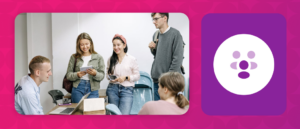Table of contents
ToggleUnderstanding how to welcome and guide new talent during their first days, weeks and months is crucial for any company. Not only does it have an immediate impact on new employees’ initial adaptation phase, but also lays the foundation for their long-term commitment to the organization.
An onboarding plan is much more than a simple formality – it is in fact a key strategy to guarantee a more friendly, positive and successful integration for new talent. Its main objective is to facilitate the smooth transition of new employees into the structure and culture of the organization. This is achieved by offering helpful guidance and delivering relevant information, which has the effect of making newcomers feel more welcome, confident and secure.
There are many ways to implement an onboarding plan. In this article we’ll explore the essential components that any successful onboarding plan requires, as well as consider several examples that you can implement in your own organization.
The importance of a good onboarding plan for business success
Several crucial factors for the success of a company depend on a good onboarding plan, including productivity, employee retention and their level of commitment. By providing a clear understanding of expectations and objectives from the beginning, you can reduce the chances of any misunderstandings, and increase the likelihood that employees will contribute effectively to achieving your wider business goals.
Forging positive relationships that make for a warm welcome to new co-workers ultimately contributes to a harmonious and positive work environment. This has a direct impact on employee morale, and motivation is, of course, one of the most effective ways to improve retention rates. In fact, according to Deloitte, 22% of turnover usually takes place within the first 45 days of employment.
Moreover, the better the employee onboarding process, the greater their contribution to the company will be. This is because they’ll start out with a good understanding of the organization’s culture, as well as access to all the information they need to carry out their work effectively. In turn, this will help improve the external image of the company and sharpen its competitiveness edge. If you want to learn more about the advantages of a good onboarding plan for new employees, we invite you to read this article.
Essential components of an effective onboarding plan
Every onboarding plan is structured in several phases, and each of them fulfills a specific purpose. Ensure that the following essential components are not missing from your plan’s structure:
Official welcome
The official welcome marks the beginning of the new employee’s experience at the company. This phase is not just about business formalities, but should seek to set a positive and welcoming tone. Welcomes usually include an introduction to the management team, a map or plan of the office, and a guide to the corporate culture.
Company presentation
Giving an overview of the company is essential to help employees understand the role they play in a broader context. This step requires you to communicate the mission, vision and strategic objectives of your organization, providing a panoramic vision that inspires commitment.
Introduction to the work team
Connecting new employees with their colleagues is crucial to fostering a sense of belonging. A solid introduction to the work team allows a newcomer to form professional and personal ties with others, contributing to a collaborative and successful work environment.
Job description and expectations
Clarifying the responsibilities and expectations associated with the position is essential to avoid misunderstandings and promote efficiency. This component of the onboarding plan allows employees to clearly understand their role and how it contributes to the overall success of the company.
Politics and procedures
A clear presentation of internal policies and operating procedures is vital for compliance and harmony within the organization. The information covered should range from ethical and behavioral issues to human resources policies and internal processes, providing a clear framework for action.
Introduction to systems and tools
To ensure that employees are productive from the start, it’s crucial to familiarize them with the essential systems and tools used within the company. This phase of the onboarding plan focuses on training through technological platforms, and the use of specific pieces of software, as well as any other resources needed to carry out assigned tasks effectively.
Training
The last key component of the onboarding plan is training, which should be continuous, developing and adapting to the changing dynamics of the work environment. Providing specific training programs according to the needs of each employee contributes to their growth, and allows them to constantly improve their skills, thereby guaranteeing a significant and lasting boost to business success.
7 onboarding plan examples you can implement in your company
The best employee onboarding plan is one that provides a new team member with all the information they need for an easy adaptation. But originality is also key – don’t be afraid to get creative when it comes to designing your plan. Looking for a little inspiration? We offer the following suggestions:
1. Make a custom welcome box
Imagine the scene – it’s your very first day at a new company, and suddenly you receive a welcome box designed exclusively for you. This box could contain a mixture of objects – not only helpful company information such as manuals and policies, but also personalized items, such as a mug bearing the company logo (for that all-important coffee!), stationery, and a welcome letter from the management team. A touch like this not only informs, but also creates a warm and welcoming environment from day one.
2. Design a treasure hunt
Transform the act of getting familiar with new surroundings into an exciting treasure hunt. New employees can explore the office to discover different areas, interact with colleagues, and locate key pieces of information about the company. This playful approach not only facilitates learning, but also encourages collaboration and teamwork from the beginning.
3. Provide an illustrated manual for new employees
Instead of offering a traditional manual, you could create a much more fun illustrated one. Use graphs, images and bullet-points to provide a more visual, easy-to-understand perspective on the company’s culture, values, organizational structure, and key policies. This is an attractive format that improves the assimilation of information and strengthens employee retention.
4. Set up a ‘Connection Café’
Hosting regular sessions which give new employees the opportunity to meet team members in an informal setting is a great idea. It’s a great way to encourage new employees to make connections, facilitating integration and fostering authentic conversations – all of which strengthens professional relationships in a relaxed environment.
5. Assign an onboarding partner
Assign each new employee an onboarding buddy – an experienced colleague who acts as a guide and mentor during their first few months. This relationship creates an immediate connection and provides a reliable source of support, helping newcomers adapt more quickly to an unfamiliar work environment.
6. Hold an integration challenge
Designing an onboarding challenge is a good way to motivate new employees to collaborate on projects or solve company-specific problems. This activity not only encourages teamwork, but also allows newcomers to demonstrate their specific skills.
7. Decorate the desktop
A great idea to welcome a new employee to the office is decorating their desk with balloons, a welcome sign or even equip it with company material such as pens, notebooks or a customized water bottle. This will make them feel welcome – a simple touch, but a significant detail.
How to design your own onboarding plan with isEazy
Now you know the importance of an onboarding plan, and all the components you need to make it a success, it’s time for you to design your own. And, to make it easy for you, we present isEazy Engage, the onboarding app for new employees that makes the whole process a breeze, improving the employee experience every step of the way. All of this from the palm of your hands!
Our app offers you a wide array of features. It all starts with the pre-onboarding phase, where you can give your employees all the documentation and guidance they need before joining in person. Keep the process going right through to the welcome, presentation, and incorporation phases with features guaranteed to boost autonomy and productivity.
Your employees will enjoy personalized training in skills, processes or products, through micro impacts designed to enhance their workflow. In addition, they’ll find all the information they need for their crucial first days in just one click, as well as agile communication channels that keep them connected, wherever they are. So what are you waiting for? Improve the experience of your new employees today! Request a demo and start enjoying the advantages.














